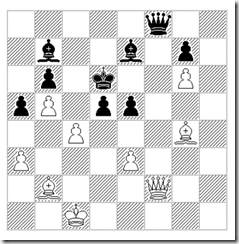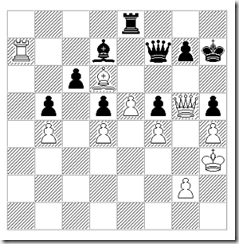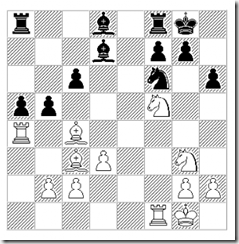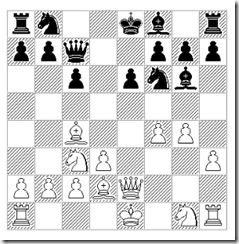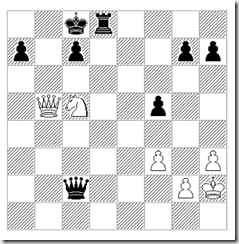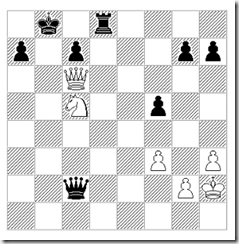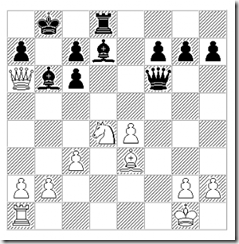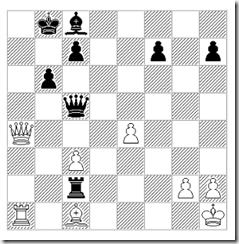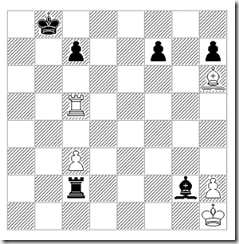An unexamined life is not worth living.
Wednesday, December 14, 2016
Best Chess Combinations of 2016 (Modern Chess Tactics) video
Wednesday, December 7, 2016
Modern Chess Combinations–Volume 7
Modern Chess Combinations: July, August, September 2016 is now out with over 120 puzzles for you to solve. It is available on Amazon. The Kindle free sample contains dozens of combinations, so you can first practice those positions and see if you like the selection. This publication is a collection of over 120 best combinations played by strong chess players in tournaments that took place the third quarter of 2016. I first filtered the correct combinations with various computer-assisted approaches, and then manually went through the entire collection to select only the puzzles useful to practical chess players.
The highlight of this edition are the games from the Chess Olympiad, where the USA team won the gold medal in the main tournament. Here are a couple of samples:
Heberla, B. - Ali Marandi, C.
TCh-TUR Super League 2016 2016.08.05 , B13
Solution: 30. Re1!!
- Putting the rook under attack, but the bishop must guard the d8 square.
- ( 30. ... Bxe1+ 31. Kxe1 fxg5 32. d8=Q+ )
- The final blow, since the pawn must be captured.
Indjic, A. - Cruz, Cr
42nd Olympiad 2016 2016.09.08 , E38
Solution: 32. Bxe5+!?
- The first move suggest itself, but the correct follow up is harder to find.
- ( The obvious 33. Qh2+? fails to 33. ... Ke4 )
- ( 33. ... Ke4 34. Qd4# )
- With the king on d6, the check along the h2-b8 diagonal is deadly.
Wednesday, November 30, 2016
History Does not Repeat itself–Two Grischuk Endgames
A curious mistake that Mark Dvoretsky would have included into his book – happened in the following game, where White voluntarily exchanged into a hopeless pawn endgame:
Robson, R. - Grischuk, A.
42nd Olympiad 2016 2016.09.10 , C67
1. e4 e5 2. Nf3 Nc6 3. Bb5 Nf6 4. O-O Nxe4 5. Re1 Nd6 6. Nxe5 Be7 7. Bf1 Nxe5 8. Rxe5 O-O 9. Nc3 Ne8 10. Nd5 Bd6 11. Re1 c6 12. Ne3 Bc7 13. Nf5 d5 14. Ne7+ Kh8 15. Nxc8 Rxc8 16. g3 Qf6 17. Bh3 Rd8 18. d4 Nd6 19. Bf4 Bb8 20. Be5 Qh6 21. Bg2 Nc4 22. Bxb8 Rxb8 23. b3 Nd6 24. Qd3 Qg6 25. Qd2 Rfe8 26. Re5 f6 27. Rxe8+ Rxe8 28. Qb4 f5 29. Re1 Rxe1+ 30. Qxe1 Qf6 31. Qe3 g5 32. f4 h6 33. a4 a5 34. Kf1 Ne4 35. c4 Kg7 36. c5 gxf4 37. gxf4 Qh4
38. Bxe4?- ( 38. Bh3!? )
- The position is objectively lost, but trading queens makes things too easy for Black.
Interestingly, it was pointed out to me that Grischuk had lost a pawn endgame that was a complete mirror of this position only three years earlier:
Le Quang Liem - Grischuk, Alexander
2013 , D87
1. d4 Nf6 2. c4 g6 3. Nc3 d5 4. cxd5 Nxd5 5. e4 Nxc3 6. bxc3 Bg7 7. Bc4 c5 8. Ne2 Nc6 9. Be3 O-O 10. O-O b6 11. Qd2 Bb7 12. Rfd1 Rc8 13. Rac1 e6 14. Bh6 cxd4 15. cxd4 Qh4 16. Bxg7 Kxg7 17. Qe3 Rfd8 18. h3 Qe7 19. Bb5 Qb4 20. Rb1 Qe7 21. Nf4 Nb4 22. d5 Nc2 23. Qg3 e5 24. Ne2 Na3 25. Rb3 Nxb5 26. Rxb5 Ba6 27. Rb2 Bxe2 28. Rxe2 Qd6 29. Qd3 Rc5 30. Rc2 Rdc8 31. Rdc1 Kf8 32. Qa3 Qe7 33. Rxc5 Rxc5 34. Rxc5 Qxc5 35. Qxc5+ bxc5 36. Kf1 Ke7 37. Ke2 f5 38. f3 Kd6 39. Kd3 f4 40. h4 Kc7 41. Kc4 Kd6
42. Kb5- The protected passed pawn decides matters as Black is unable to defend c5 pawn in the long run and is falling into Zugzwang.
'History doesn't repeat itself but it often rhymes' as Mark Twain supposedly has said ...
Thursday, November 17, 2016
Carlsen–Karjakin – Game 5 with opposite coloured bishops
Karjakin’s d5-d4 pawn break in today’s game really reminded me of the move that I played almost 10 years ago in a position with similar material (bishops of opposite colour) and ideas:
Carlsen–Karjakin match, 2016 – Game 5 Karjakin played 42…d5-d4! with initiative
Karjakin played 42…d5-d4! with initiative
Jiganchine – Trotchanovich, Keres 2007 White to move.
White to move.
I also analyzed this game in the book Spanish Opening - Strategy and Tactics, here is the full analysis:
Jiganchine, Roman - Trotchanovich, Pavel
Keres Memorial 2007 2007.05.20 , C80
1. e4 e5 2. Nf3 Nc6 3. Bb5 a6 4. Ba4 Nf6 5. O-O b5 6. Bb3 Nxe4 7. d4 d5 8. dxe5 Be6 9. Nbd2 Nc5 10. c3
10. ... Nxb3?!- This is a positional mistake, as now White's control over d4 and c5 becomes very firm. Black instead had 3 main moves: 10... Bg4, 10... Be7, and 10... d4, the last of which was played in the Karpov-Korchnoi game.
- ( 12. ... Nxe5 is considered dangerous - Black is likely to lose material 13. Re1 Ng6 14. Nxe6 fxe6 15. Nd4 e5 16. Ne6 Qd7 17. Qxd5! Qxd5 18. Nxc7+ Kf7 19. Nxd5 +/- )
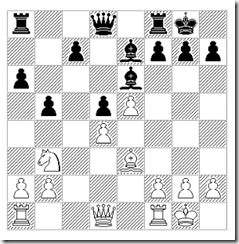 White won the majority of the games that arrived at this position. Black's pieces are rather passive, and he has no compensation for the weaknesses along the 'c' file. However to exploit his position, White would have to build up pressure on both sides of the board and only then execute a breakthrough. His plan is roughly as follows:
White won the majority of the games that arrived at this position. Black's pieces are rather passive, and he has no compensation for the weaknesses along the 'c' file. However to exploit his position, White would have to build up pressure on both sides of the board and only then execute a breakthrough. His plan is roughly as follows: - establish a knight on 'c5' and control the 'c' file
- advance pawns on the kingside and resolve the pawn structure there
- activate the dark squared bishop to the a3-f8 diagonal
- use the third rank for manoeuvres of heavy pieces and build pressure on both sides of the board
- once Black pieces are tied up - either engineer a pawn break, or open a file and invade with heavy pieces.
- ( 14. ... f6 was a bit more active, but did not fundamentally change the evaluation of the position. )
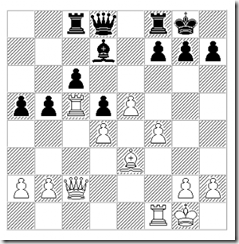 Not only White is putting pressure on the queenside, but he also wants to advance with f4-f5-f6, so Black has to prevent that somehow.
Not only White is putting pressure on the queenside, but he also wants to advance with f4-f5-f6, so Black has to prevent that somehow.
- A committal move, as now the 'e' pawn will need to be continually watched by Black.
- ( Also possible was 19. ... g6 20. f5! Bxf5 21. Qd2 and White has great compensation for the sacrificed pawn, as Black's dark squares are very weak. 21. ... Qd7 22. Bh6 Rfe8 23. Bg5 h5 24. Bf6 Kh7 25. Qg5 a4 26. Rf4 a3 27. b3
 and White can continue to build up pressure, with possible sacrifices either on 'f5' or on 'h5'. Black's position cannot be saved. )
and White can continue to build up pressure, with possible sacrifices either on 'f5' or on 'h5'. Black's position cannot be saved. )
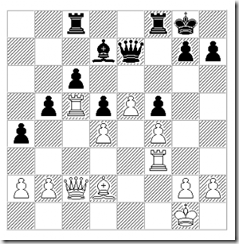 Black has completely surrendered the dark squares, tying all hopes to passive defence. Such positions however are very unpleasant to defend as White can combine threats on both sides of the board. The game goes on for quite a while from here, but Black is always struggling due to the weaknesses of his position.
Black has completely surrendered the dark squares, tying all hopes to passive defence. Such positions however are very unpleasant to defend as White can combine threats on both sides of the board. The game goes on for quite a while from here, but Black is always struggling due to the weaknesses of his position.
- Black manages to trade off one pair of rooks, which is probably to his advantage.
- Now my main risk is that Black will trade off the second rook the same way, so I tried to go back and forth, hoping to tie up the black rook to be guarding e6 or the a file.
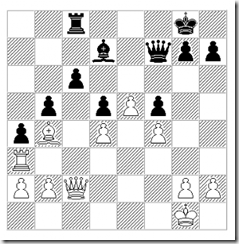 One of White's ideas is to play b2-b3, and invade on the 'a' file. This has to be timed very carefully, of course.
One of White's ideas is to play b2-b3, and invade on the 'a' file. This has to be timed very carefully, of course.
- ( With his last move Black made sure that he is prepared to meet 29. b3 axb3 30. axb3 with 30. ... Ra8 )
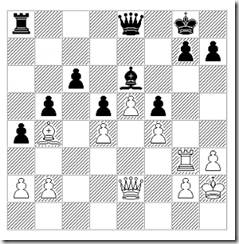 With the queenside threats, White forced Black to put the rook to 'a8', and now Black is unable to quickly transfer the rook to g6.
With the queenside threats, White forced Black to put the rook to 'a8', and now Black is unable to quickly transfer the rook to g6.
- White is preparing to play e5-e6 and Be5 with pressure on g7 at the right time.
- ( 42. Qxg6 hxg6 would only give small winning chances, for example - opposite colour bishop endgame has some promise if white brings king on b6 and takes on g7 with bishop, and creates passed pawn on kingside - but there is only a remote chance of that happening. )
- Going back to the idea of generating play on the queenside. It is essential in the Spanish opening to play on both sides of the board, especially if White wants to convert his spacial advantage into a win.
- ( It would be logical for Black to take over the 'a' file, but then I was hoping to generate enough pressure on kingside: After 47. ... Ra8 there was a brilliant (but predictable ) sacrifice: 48. e6!! Bxe6 49. Be5 Rg8 ( 49. ... Ra7 50. Bxg7+ Qxg7 51. Qd8+ Bg8 52. Rxg7 Rxg7 53. Qf6 +- ) 50. h4!!
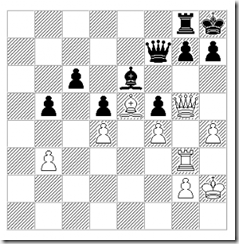 and Black is completely helpless against h4-h5-h6 50. ... Qg6 ( 50. ... Bd7 51. h5 and Qg6 is no longer an option ) 51. Qxg6 hxg6 52. Rxg6 with double threat Rxe6 and Rh6 mate! 52. ... Kh7 53. Rxe6 +- )
and Black is completely helpless against h4-h5-h6 50. ... Qg6 ( 50. ... Bd7 51. h5 and Qg6 is no longer an option ) 51. Qxg6 hxg6 52. Rxg6 with double threat Rxe6 and Rh6 mate! 52. ... Kh7 53. Rxe6 +- )
- ( White was winning immediately after 56. Bf8! Qxf8 57. Rxd7 Rh6 58. g3 with zugzwang! 58. ... Rg6 59. Qxh5+ Rh6 60. Rf7! Rxh5 61. Rxf8 with a completely winning rook endgame for White. )
- White gives up the pawn to free up the e5 square for his bishop and to disrupt the coordination of the black pieces.
- ( 57. ... Rxe6? 58. Qd8 +- )
- ( 63. ... Qe1! +/- was the best chance. )
- Black tries to prevent Bd6
- ( 66. ... gxh6? 67. Bd6 Bh7 68. Be5+ Kg8 69. Rg7+ Kf8 70. Rxh7 +- )
- With the king in the corner, Black clearly has no chance to save this endgame. Opposite colours of the bishops do not help Black because there are still rooks present on the board.
- It took a lot of moves for White to win the game, but the entire course of the game gave Black very little hope of escaping from the strategic bind.
Monday, November 14, 2016
Blast from the past - Carlsen outplays Karjakin in a tricky endgame - video
This game and analysis is taken from my E-book about endgames with bishops of opposite color.
Saturday, November 12, 2016
Finding the only path to victory
 Black to move
Black to moveIf you guessed the first few moves correctly, then there is another sequence of “only moves” that needs to be found:
 Black to move
Black to moveThere are plenty of candidate moves to consider – …Rf2, Bxh3, Ng3, Nf4, etc, but only one leads to the win. Can you find it?
Interestingly, when I made a video about this game – I had thought that Black only has a draw here.
Saturday, October 22, 2016
Building Chess Opening Repertoire - Video Tutorial
If you intend to store your opening preparation in a computer database, this method will save you a lot of time with a well tested approach.
Sunday, October 16, 2016
How to Study Chess Openings – Guide Ebook
I have just published a new ebook that summarizes many of the writings on this blog, with many additions and revisions. It covers many aspects of opening preparation that I think are largely missing in current chess literature and I had to struggle to discover on my own, of course with great help from my mentors over the years. It is available on Amazon and Kobo.
From the introduction:
There is an interesting paradox in the chess community - many coaches and teachers warn players of all levels against the excessive obsession with opening theory and yet the vast majority of chess materials in digital or printed form are dedicated to specific opening variations or positions. While everyone admits that memorizing variations will never guarantee success in over the board or online encounters, there is clearly a demand for products that help chess players of all levels to successfully navigate through the first stage of the game. At the same time, there is a lack of detailed discussion regarding how seasoned players (expert level and above) structure their work on chess openings, store their analysis, come up with new ideas, prepare for tournament games and so on. Rather than provide another set of variations, key positions and critical games in a specific opening area, this book is meant to fill this gap and help the reader to make sense from all the information that is out there and save as much time and energy as possible, while still building a bulletproof opening repertoire. The book is aimed at any chess player who wants to improve their opening play and is looking for some guidance in that area.
Despite the large proliferation of computer chess software, there is a lack of explanation for how to tie to it effectively to one's study of openings. In the most advanced book on the subject, 'Opening Preparation', published in 1990s, the renowned coach Mark Dvoretsky, while giving great coverage for other topics, described the system for storing opening analysis on paper cards, with a side note that this was outdated and software should be used instead and that this was a large topic deserving a separate discussion. Since then there was a deafening silence on the subject in chess books, at least partially inspiring this publication, which outlines the system for storing opening analysis that served the author well for almost a decade.
Good opening preparation is all about picking the right direction for opening research and investing time into fine-tuning the understanding of favourable positions that are most likely to occur in our games. The basic premise throughout the book is to base one's opening preparation on 3 E's:
- Enjoyable - the positions that you analyze during opening preparation should appeal to your chess taste, and the process itself should feel pleasant and creative. See the section on 'Creativity' for more details.
- Effective - ultimately it should bring good results during tournament games, and be targeted at the positions that are most likely to occur on the board. This is covered under sections on Cutting Opponent's Options, Transpositions, and so on. Our choice of opening variations is more likely to make our work effective than anything else.
- Efficient - this not as important as effectiveness, but we still don't want to waste time and analysis, so various computer tools are suggested to optimize the 'how' of opening analysis, save our work, and efficiently retrieve it.
While it has plenty of examples and annotated games, this book deals with opening preparation in general. For books on specific openings, the reader might want to explore other books in the "Opening Preparation" Series:
- Spanish Opening - Strategy and Tactics also serves as a repertoire book for White
- Exchange Slav - Strategy and Tactics covers the particular opening and pawn structure for both sides
- Isolated Queen Pawn: Strategy and Tactics spans multiple openings, but focuses on a single common pawn structure
Contents:
1. Introduction
2. Building a Repertoire - Motivation and General Principles
2.1. Opening Preparation - Therapeutic?
2.2. Gaining Advantage on the Clock
2.3. Acceleration of Play - How Faster Time Controls Affect Preparation
3. Building a Repertoire - How to Do This
3.1. Developing repertoire - Write it Down!
3.2. How To Make a Tree in Digital format
3.2.1. Step 1 - Obtain and Format the Database with ECO list of Openings
3.2.2. Step 2 - Select and Tag Openings that Belong to your Repertoire
3.2.3. Step 3 - Add Custom Analysis in a Separate Database that Contains only Repertoire Openings
3.3. Example of a Specific Opening Preparation - Two Knights Defence for Black
3.4. Building Repertoire - Cutting out Opponent's Options
3.5. Reducing Material to Learn - Transpositions to the Rescue
4. Creativity
4.1. Ideas That Work Across Openings
4.2. Noticing Patterns - Seeing the Forest for the Trees
5. Learning from the Grandmasters
5.1. Jonny Hector's wins against 4.Ng5 in the Two Knights Defence
5.2. Short approach against the Scandinavian
5.3. Pavasovic attacks with Isolated pawn
5.4. Nadezhda Kosintseva plays with Isolated Pawn to beat the French
5.5. Ilya Smirin's games Vs The French, Delayed Castling, attacking Pawn Chain, etc ...
5.6. Studying the Classics
5.7. How to Find New Chess Ideas
6. Common Mistakes During Opening Preparation
6.1. Trusting your Sources without Applying your Intuition
6.2. The Impact of Computers on Opening Preparation
6.3. Overestimating Opponent's Preparation
7. Opening Duels - Specific Opponent and Opening Preparation
7.1. Alapin Sicilian - How Dangerous is the Kingside Attack?
7.2. Central Gambit - Move Order Tricks
7.3. Najdorf Sicilian - Avoiding Time Trouble
7.4. Queen's Gambit Accepted - Opening Advantage does not Guarantee Success
7.5. Queen's Gambit Accepted - Choosing a Pawn Structure
7.6. Repairing the Repertoire
7.7. Following the Middlegame plan
8. Memorizing Openings
8.1. Information Overload
8.2. Memorizing Chess Openings
8.3. Why Less Is More When it Comes to Opening Repertoire
8.4. Anand on Studying Chess with Computers and Memory
9. Summary - Checklists
9.1. 10 steps to a Better Chess Opening Repertoire
9.2. Checklist for Maintaining Opening Repertoire in Digital Form
9.3. 10 Additional Reasons to Build an Opening Repertoire
10. About the Author
11. Symbols and Abbreviations Used in the Book
11.1. Position Evaluation
11.2. Move Evaluation
Saturday, October 15, 2016
Book Review – Learn from the Legends: Chess Champions At Their Best
As a fan of chess books about history and personalities, I found Mikhail Marin's books to be a sweet spot that merges the interesting stories with instructive material in the most seamless and natural way. In Learn from the Legends: Chess Champions At Their Best, by virtue of the author discussing each player's favourite type of positions or material balance - the reader gets to see how subtle superiority in understanding of those positions allowed great champions (Rubinstein, Alekhine, Tal and others) to outplay their opponents again and again. As the patterns are well explained the reader cannot help, but want to pursue each topic in their own games and study. The book has a lot of deep analysis, but one does not feel overwhelmed with variations because they are all tied together with ideas that the author is consistently trying to illustrate. Highly recommended!
PS. In fact this approach of finding themes in games of top several top players is quite a popular inspirations for chess books, and I used a similar idea for my book The Break - Learn From Schlechter, Botvinnik and Kramnik where I explore the topic of unexpected pawn breaks and sacrifices.
Friday, September 30, 2016
Chess Games by Alexander Morozevich - video collection
Attack with Alexander Morozevich - Selected Games and Best Combinations
Counterattack with Alexander Morozevich
Saturday, September 17, 2016
Modern Chess Combinations - volume 6
Modern Chess Combinations: April, May, June 2016 (Quarterly Chess Tactics) is now out with over 150 puzzles for you to solve. It is available on Amazon and on Kobo. The Kindle free sample contains dozens of combinations, so you can first practice those positions and see if you like the selection. This publication is a collection of over 150 best combinations played by strong chess players in tournaments that took place the second quarter of 2016. I first filtered the correct combinations with various computer-assisted approaches, and then manually went through the entire collection to select only the puzzles useful to practical chess players.
The book is the second volume in the "Quarterly Chess Tactics" series for 2016, which provides instructive tactical positions from the most recent top chess tournaments.
The highlight of this edition is the series of blitz and rapid games that were played by the world's top players in several events across the world and on the Internet (Grand Chess Tour, Chess.com championship and others). As a result the tactics are easier to spot because in blitz games even the best players make mistakes and allow elegant combinations, which they would have prevented in classical time controls.
Saturday, September 10, 2016
VIdeo - New Blog - Daily Chess Tactics from Most Recent Top Tournaments
http://chesspublisher.blogspot.com will help chessplayers to develop combination solving ability on a daily basis. The puzzles appear daily and you can take you time to figure out the solution and then see the answer by clicking on the question mark. You can also have these puzzles appear in your RSS reader by subscribing to the Daily Chess Tactics feed or you can follow it by email. Also available in Kindle format - http://goo.gl/D32wg0. More details also at http://roman-chess.blogspot.ca/2016/02/subscribe-to-new-blog-daily-chess.html .
Sunday, August 28, 2016
Attacking on Both sides in Closed Spanish
When White closes the center with d4-d5 in the Spanish Opening, his next goals are roughly as follows:
- advance f2-f4-f5 to gain space on the kingside
- Open up the ‘a’ file to have the option of invading on that file with the rook.
- build up piece pressure on the kingside
Here are a couple of examples of how to combine these ideas:
Dominguez Perez, Leinier - Hernandez Onna, Roman
Guillermo Garcia Memorial-B 08th 2000.06.03 , C98
1. e4 e5 2. Nf3 Nc6 3. Bb5 a6 4. Ba4 Nf6 5. O-O Be7 6. Re1 b5 7. Bb3 d6 8. c3 O-O 9. h3 Na5 10. Bc2 c5 11. d4 Qc7 12. Nbd2 Nc6 13. d5 Nd8 14. a4 Rb8 15. axb5 axb5 16. b4 c4 17. Nf1 Ne8 18. Ng3 g6 19. Nh2 Ng7 20. Rf1 f6 21. f4 Nf7
22. f5 g5 23. h4 gxh4 24. Nh5 Nxh5 25. Qxh5 Bd8 26. Ng4 Kh8 27. Qxh4 Qe7 28. Be3 Rg8 29. Ra7 Bb7 30. Rfa1 Rg7 31. Kf1 Kg8 32. R1a5! Bxa5 33. Nxf6+ Kh8 34. bxa5 Ra8 35. Rxa8+ Bxa8 36. a6 Qd8 37. g4 Qa5 38. Nh5 Qa1+ 39. Kf2 1-0Bucinskas, Valdas - Ould Ahmed, Samy
olm17 qual GP1 B4 email 2006.01.10 , C98
1. e4 e5 2. Nf3 Nc6 3. Bb5 a6 4. Ba4 Nf6 5. O-O Be7 6. Re1 b5 7. Bb3 d6 8. c3 O-O 9. h3 Na5 10. Bc2 c5 11. d4 Qc7 12. Nbd2 Nc6 13. d5 Nd8 14. a4 Rb8 15. axb5 axb5 16. b4 c4 17. Nf1 Ne8 18. N3h2 f6 19. Ng3 g6 20. Rf1 Ng7 21. f4 Nf7 22. f5 Qb6+ 23. Kh1 gxf5 24. exf5 Bb7 25. Qg4 Kh8 26. Nf3 Rfe8 27. Nh4 Bd8 28. Be4 Qc7
29. Ng6+! Kg8- ( 29. ... hxg6 30. Qh4+ Kg8 31. fxg6 +- )
Saturday, August 6, 2016
Daily Chess Tactics from Most Recent Top Tournaments - Video Overview
http://chesspublisher.blogspot.com will help chessplayers to develop combination solving ability on a daily basis. The puzzles appear daily and you can take you time to figure out the solution and then see the answer by clicking on the question mark. You can also have these puzzles appear in your RSS reader by subscribing to the Daily Chess Tactics feed or you can follow it by email. Also available in Kindle format - http://goo.gl/D32wg0.
Monday, July 25, 2016
Short approach against the Scandinavian
Nigel Short has played several interesting games against the 2…Qd5 Scandinavian where White went for the setup with Bc4, d3, Bd2, and Qe2, preparing long castle. Initiative is surprisingly long lasting and in all 3 games – persisted into the endgame. Here is the illustrated summary of several key positions:
Short, Nigel D - Gonzalez, Renier
2007 , B01
1. e4 d5 2. exd5 Qxd5 3. Nc3 Qa5 4. Bc4 Nf6 5. d3 c6 6. Qe2 Nbd7 7. Bd2 Qe5 8. a4 Qxe2+ 9. Ngxe2 a5 10. O-O e6 11. Ne4 Be7 12. f4
12. ... Nc5 13. Ng5 O-O 14. Ng3 b6 15. f5 15. ... h6 16. Nf3 exf5 17. Nd4 Bd7 18. Ndxf5 Bd8 19. Bc3 Nxa4 20. Rxa4 b5 21. Nxg7!? bxa4- ( 21. ... Kxg7 22. Nh5+ Kg6 23. Nxf6 Bxf6 24. Rxf6+ Kh7 25. Bxb5 cxb5 26. Rh4 +/- )
- ( 31. Bxe7+ +- )
Short, Nigel D - Ateka, Nathan
2013 , B01
1. e4 d5 2. exd5 Qxd5 3. Nc3 Qa5 4. Bc4 Nf6 5. d3 c6 6. Bd2 Qc7 7. Qe2
7. ... Nbd7 8. a3 Nb6 9. Ba2 Bg4 10. Nf3 e6 11. h3 Bh5 12. g4 Bg6 13. O-O-O Bd6 14. Rde1 O-O-O 15. Ne5 Bxe5 16. Qxe5 Qxe5 17. Rxe5 Nbd5 18. f4 Nxc3 19. Bxc3 Nd5 20. Bxd5 cxd5 21. Bd4 a6 22. f5 22. ... exf5 23. gxf5 f6- ( 23. ... Bh5 24. f6 gxf6 25. Rxh5 )
Short, Nigel D - Lioe Dede
2004 , B01
1. e4 d5 2. exd5 Qxd5 3. Nc3 Qa5 4. Bc4 Nf6 5. d3 c6 6. Qe2 Bf5 7. Bd2 Qc7 8. h3 e6 9. g4 Bg6 10. f4
10. ... Be7 11. Nf3 Nbd7 12. O-O-O Nb6 13. Rde1 Kf8 14. Bb3 Bd6 15. Ne5 Bxe5 16. Qxe5 Qxe5 17. fxe5 Nfd7 18. Ne4 Kg8 19. d4 h5 20. g5 Bxe4 21. Rxe4 Nd5 22. Rf1 g6 23. Bxd5 cxd5 24. Ref4 Rh7 25. Bb4 Nb8 26. Bd6 Nc6 27. R1f3 Rd8 28. b3 Rd7 29. Kd2 Ne7 30. Bxe7 Rxe7 31. Rc3 Kg7 32. Rc8 Rh8 33. Rxh8 Kxh8 34. Rf3 Kg8 35. Rc3 Kf8 36. a4 +/- 36. ... Ke8 37. Rc8+ Kd7 38. Ra8 a6 39. Kc3 Kc6 40. Kb4 Rc7 41. c4 dxc4 42. bxc4 Kd7 43. Rb8 Kc6 44. a5 Kd7 45. d5 exd5 46. cxd5 Rc1 47. Rxb7+ Ke8 48. Ra7 Kf8 49. Rxa6 Rh1 50. Rf6 Rxh3 51. e6 Rg3 52. Rxf7+ Ke8 53. a6 1-0Sunday, July 10, 2016
Where to Sacrifice the Knight?
 White to move. Solution.
White to move. Solution.I played what seemed like an obvious sacrifice, but the computer found that in fact I made a wrong choice. What does your intuition suggest to you?
Sunday, June 26, 2016
Mikhalevski’s Sharp games in 5…Ne4 variation of Four Knights Scotch
In case 5…Ne4 variation of Four Knights Scotch sounds like a mix of various buzzwords, this refers to the first moves 1. e4 e5 2. Nf3 Nc6 3. Nc3 Nf6 4. d4 exd4 5. Nxd4 Nxe4 which seems to be dropping a piece, except for it does not.
Alexander Mikhalevski seems to be among the strongest players who ever tried this line, with mixed results as the following two super sharp games illustrate:
Sutovsky, Emil - Mikhalevski, Alexander
1994 , C47
1. e4 e5 2. Nf3 Nc6 3. Nc3 Nf6 4. d4 exd4 5. Nxd4 Nxe4 6. Nxe4 Qe7 7. f3 d5 8. Bb5 Bd7 9. O-O dxe4 10. Bxc6 bxc6 11. Re1 O-O-O 12. Rxe4 Qf6 13. Qe2 c5 14. Nb3 Qb6 15. Be3 Bd6 16. Qf2 f5 17. Rc4 Qb5
18. Rc3 c4 19. Bc5 Bc6- ( 19. ... cxb3 20. Bxd6 )
- ( 35. ... Qb2 36. Na6+ Kc8 37. Qxc7# )
Timmerman, Gert - Mikhalevsky, Alexander
1996 , C47
1. e4 e5 2. Nf3 Nc6 3. d4 exd4 4. Nxd4 Nf6 5. Nc3 Nxe4 6. Nxe4 Qe7 7. f3 d5 8. Bb5 Bd7 9. Bxc6 bxc6 10. O-O dxe4 11. Re1 O-O-O 12. Rxe4 Qf6 13. Qf1 Bc5 14. Qa6+ Kb8 15. Be3 Rhe8 16. c3 Rxe4 17. fxe4 Bb6
18. a4 c5- Activating the light squared bishop is essential in this structure.
- ( 21. ... dxe3?? 22. Qxc7+ Ka8 23. Qxa7# )
- ( 23. Qa2 Bb7 24. Qa7+ Kc8 )
- In return for the pawn Black gets to activate his pieces, which is always important in positions with bishops of opposite color.


